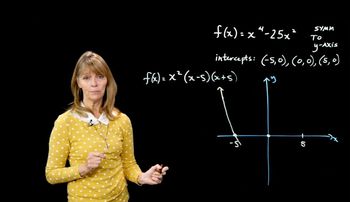Table of contents
- 0. Review of Algebra4h 16m
- 1. Equations & Inequalities3h 18m
- 2. Graphs of Equations43m
- 3. Functions2h 17m
- 4. Polynomial Functions1h 44m
- 5. Rational Functions1h 23m
- 6. Exponential & Logarithmic Functions2h 28m
- 7. Systems of Equations & Matrices4h 6m
- 8. Conic Sections2h 23m
- 9. Sequences, Series, & Induction1h 19m
- 10. Combinatorics & Probability1h 45m
4. Polynomial Functions
Dividing Polynomials
Problem 21
Textbook Question
In Exercises 17–32, divide using synthetic division. (4x^3−3x^2+3x−1)÷(x−1)
 Verified step by step guidance
Verified step by step guidance1
Identify the divisor and ensure it is in the form (x - c). Here, the divisor is (x - 1), so c = 1.
Write down the coefficients of the dividend polynomial 4x^3 - 3x^2 + 3x - 1, which are 4, -3, 3, and -1.
Set up the synthetic division by writing c = 1 to the left and the coefficients 4, -3, 3, -1 in a row.
Bring down the leading coefficient (4) to the bottom row.
Multiply c (which is 1) by the number just written on the bottom row (4), and write the result under the next coefficient (-3). Add this result to -3 and write the sum below. Repeat this process for the remaining coefficients.
Recommended similar problem, with video answer:
 Verified Solution
Verified SolutionThis video solution was recommended by our tutors as helpful for the problem above
Video duration:
2mPlay a video:
Was this helpful?
Key Concepts
Here are the essential concepts you must grasp in order to answer the question correctly.
Synthetic Division
Synthetic division is a simplified method for dividing polynomials, particularly useful when dividing by linear factors of the form (x - c). It involves using the coefficients of the polynomial and a specific value (c) to perform the division in a more efficient manner than traditional long division.
Recommended video:

Higher Powers of i
Polynomial Functions
A polynomial function is a mathematical expression involving a sum of powers in one or more variables multiplied by coefficients. In this case, the polynomial 4x^3 - 3x^2 + 3x - 1 is a cubic polynomial, which means its highest degree is three, indicating it can have up to three roots or solutions.
Recommended video:

Introduction to Polynomial Functions
Remainder Theorem
The Remainder Theorem states that when a polynomial f(x) is divided by (x - c), the remainder of this division is equal to f(c). This theorem is useful in synthetic division as it allows us to quickly find the value of the polynomial at a specific point, which can help in verifying the results of the division.
Recommended video:

Higher Powers of i
Related Videos
Related Practice

